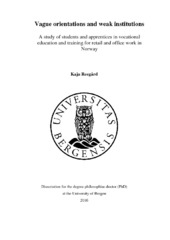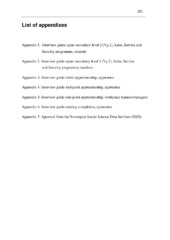| dc.description.abstract | About two decades ago, Norway expanded its well-functioning system for vocational education and training (VET) to also cover the retail sector and office work, which have no tradition of apprenticeship training. The Sales and the Office and Administration trades lack skilled role models and transparent, fixed occupational end points reserved for the skilled service worker. VET for these parts of the labour market is thus at odds with the prime intention and function of apprenticeship, which is to induct newcomers into the skills, knowledge and dispositional approaches of a trade, and to structure access to certain segments of the labour market. The topic of the thesis is the interlacing of students’ subjective experiences of the VET journey and the weakly institutionalised Sales trade and Office and Administration trade in Norway. The study is designed a qualitative longitudinal study. Data was collected in four waves of interviews with students across the duration of their education. Their subjective orientations are located within a qualitative, interpretive narrative methodological framework. The design enables the examination of process, change, and continuity, and of how the students applied hindsight and foresight to their narratives. The thesis takes the micro-level of interaction as the location of articulation, yet aims to continually include its interconnection with macro-level processes. Hence, I consulted historical documents and interviewed a wide range of relevant actors surrounding the students in different learning arenas of the course of VET, including teachers, workplace trainers, and union and employer organisation representatives. The analytical framework guiding the analysis is made up of three interlinked dimensions: (1) students’ self-understanding of their process of becoming, (2) mediated by group-level interaction in the school and workplace, and (3) structured by the trades and their capacity to socialise newcomers. Theoretically informed by concepts that underscore the dual character of action as being simultaneously bounded and broadened by institutions and social structures, the thesis finds that students’ orientations are interlaced with loosely structured institutions in the following way: When the Sales and the Office and Administration trades provide poor navigational tools to help students orientate their learning experiences, the room for individual manoeuvring becomes greater. The students’ orientations are vague, unsettled and they lack a clear conception of a career path. In the meeting between indecisive students and trades not structured by traditional vocational trade logics, few traces of vocational orientations are developed. Instead, the thesis shows how students find ways of making meaning and constructing a coherent narrative of their VET journey and the occupation they are heading towards by drawing on a range of social resources from domains outside the VET system in the dynamic process of becoming. Despite the fact that few students landed a job as a skilled retail or office worker upon training completion, their subjectively constructed narratives tell of positive outcomes such as having emotionally matured or become more self-secure, having got a break from school, obtained an education of general utility, and acquired work experience. The thesis points to different reasons to why the Sales trade and the Office and Administration trade struggle to become institutionalised. One is to be found by looking to the historical development of commerce education in Norway as a largely school-based initiative. This means that employers have developed and come to prefer training and recruitment practices disconnected the VET system. A second reason is to be found in the characteristics of the labour markets which the VET programmes are directed towards. The rapidly expanding retail sector employs mostly young people with little formal education; administrative office jobs are increasingly rationalised due to technological development, and skilled office workers are outmatched by those with higher education. These structural differences influence the learning environments of the group-level occupational communities, which again influence the learning opportunities available to students. The analysis shows how the learning environment the retail apprentices find themselves in supports their process of becoming as they receive and assume responsibility for work tasks. Being surrounded by young co-workers working part time with temporal orientations to retail work, the apprentices quickly rise to the core of the work team. The office apprentices, on the other hand, remain in the periphery of the occupational community. This marginalisation is rooted in the separation of companies’ motivation to hire apprentices from their recruitment needs. Instead of making longer-term training investments, employers within office jobs describe providing apprenticeships simply as a way of taking social responsibility. The thesis concludes that institutionalising conditions look brighter for the Sales trade because it is directed towards an expanding and more receptive labour market, where the trade certificate provides access to relevant jobs. Yet currently, the trade certificate is not required or valued in either of these occupational fields. Taken together, the findings shed light on the ways in which action is bounded, yet creative, by loosely structured, yet constraining institutions. In doing so, they illustrate the dialectical relationship between students’ vague vocational orientations and trades that are weakly anchored in the VET system. | en_US |

